Pacuare River Conservation History
Costa Rica Runs on >75% Hydropower
Protecting the Pacuare River
“I started trying to save a river and a rainforest valley that would have been ruined by being dammed. Nature would have been killed. But we did not comprehend then how far-reaching our activism would be. We ended up causing ICE to have to create environmental impact report policies. We pushed them to look into developing other alternative energies, which has led to wind, solar, and geothermal energy projects in Costa Rica, moving away from hydroelectric dams over the years.”
– Rafa Gallo
September 1980
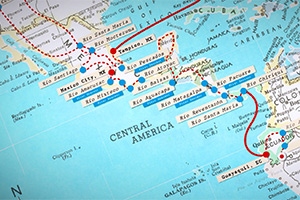 Polish explorers Piotr Chmielinski, Jerzy “Yurek” Majcherczyk, and their CanoAndes team of kayakers make the first modern kayaking descent of the upper and lower Pacuare River. Learn more…
Polish explorers Piotr Chmielinski, Jerzy “Yurek” Majcherczyk, and their CanoAndes team of kayakers make the first modern kayaking descent of the upper and lower Pacuare River. Learn more…
November 1985
 Rios Tropicales runs its first commercial trip on the Pacuare River with kayakers. To get the kayaks and gear down to the river, they used a cart pulled by an oxen team.
Rios Tropicales runs its first commercial trip on the Pacuare River with kayakers. To get the kayaks and gear down to the river, they used a cart pulled by an oxen team.
1986
April 22, 1988
1988
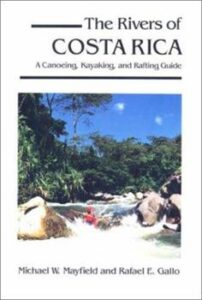 The book “The Rivers of Costa Rica” is published, co-authored by Rafael Gallo and Michael Mayfield. It is still, to this day, the definitive canoeing, kayaking, and rafting guide for Costa Rica’s rivers.
The book “The Rivers of Costa Rica” is published, co-authored by Rafael Gallo and Michael Mayfield. It is still, to this day, the definitive canoeing, kayaking, and rafting guide for Costa Rica’s rivers.
1989
Rafa Gallo founds the Pro-Rivers, Defending the Pacuare River (1989-1994). It closely partners with Friends of the River in California for fundraising.
April 22, 1990
April 23, 1990
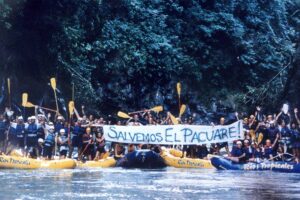 Large demonstration at the ICE camp by the entrance to Dos Montañas Canyon on the Pacuare with environmental activists, journalists, and members of the rafting and indigenous Cabecar communities stop that day’s scheduled dynamiting of the canyon as the company prepared to build its hydroelectric dam. A rotating group camps for six weeks on the beach at the entrance to Dos Montañas Canyon to prevent ICE from doing any dynamiting or other invasive action on the river.
Large demonstration at the ICE camp by the entrance to Dos Montañas Canyon on the Pacuare with environmental activists, journalists, and members of the rafting and indigenous Cabecar communities stop that day’s scheduled dynamiting of the canyon as the company prepared to build its hydroelectric dam. A rotating group camps for six weeks on the beach at the entrance to Dos Montañas Canyon to prevent ICE from doing any dynamiting or other invasive action on the river.
April 1990
Rafael Gallo and Fernando Esquivel begin legal proceedings against ICE to require an independent third-party environmental impact study on the dam site, and win. Victory changes Costa Rican law to require independent third-party environmental impact studies for all future infrastructure projects. Their environmental lawyer, Carlos Manuel Rodriguez, later serves three terms as Costa Rica’s Minister of the Environment.
April 22, 1991
A 7.7 magnitude earthquake centered near the port city of Limón destabilizes the proposed Pacuare River dam site’s bedrock, causing fissures in the Dos Montañas Canyon and forces ICE to eventually abandon the hydroelectric project. It is the strongest earthquake in Costa Rica’s recorded history.
September 1991
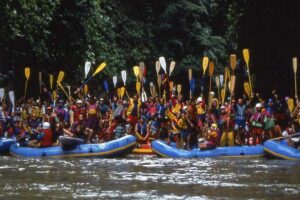 Project RAFT (Russians and Americans for Teamwork) and Rios Tropicales host an international rafting championship, called the Rainforest Festival, on the Pacuare and Reventazon rivers. Attended by over 400 international athletes, one of the event’s goals is to promote saving the Pacuare.
Project RAFT (Russians and Americans for Teamwork) and Rios Tropicales host an international rafting championship, called the Rainforest Festival, on the Pacuare and Reventazon rivers. Attended by over 400 international athletes, one of the event’s goals is to promote saving the Pacuare.
1993
September 1998
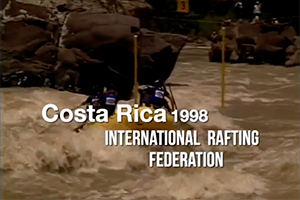 The first official IRF World Rafting Championship is held on the Pacuare and Reventazon rivers as part of the 1998 Camel Whitewater Challenge. Watch the video.
The first official IRF World Rafting Championship is held on the Pacuare and Reventazon rivers as part of the 1998 Camel Whitewater Challenge. Watch the video.
2000
August 28, 2005
2008
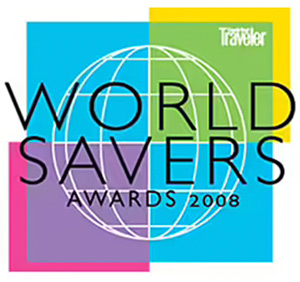 Rios Tropicales wins the Conde Nast World Savers Award.
Rios Tropicales wins the Conde Nast World Savers Award.
2008
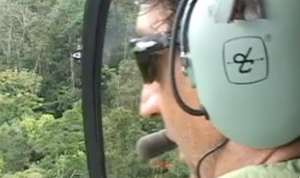 Rios Tropicales wins the first National Geographic Geotourism Challenge: Celebrating People and Place. Rios Tropicales Lodge is featured in this win.
Rios Tropicales wins the first National Geographic Geotourism Challenge: Celebrating People and Place. Rios Tropicales Lodge is featured in this win.
2009
 Rios Tropicales receives the Blue Ecological Flag for Protected Natural Spaces for its work in the Pacuare River watershed. This award also has been received annually ever since.
Rios Tropicales receives the Blue Ecological Flag for Protected Natural Spaces for its work in the Pacuare River watershed. This award also has been received annually ever since.
2010
The El Tigre Community receives a Blue Ecological Flag for River Conservation. This award was received annually from 2010 – 2016.
October 2011
 The IRF World Rafting Championship returns to the Pacuare River, organized by Rios Tropicales, and becomes the first-ever Certified Carbon Neutral world championship sporting event.
The IRF World Rafting Championship returns to the Pacuare River, organized by Rios Tropicales, and becomes the first-ever Certified Carbon Neutral world championship sporting event.
August 28, 2015
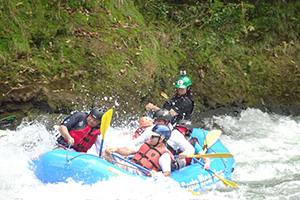 Costa Rican President Luis Guillermo Solis goes rafting with his family and advisors down the Pacuare River. At the end of the trip, he signs a Presidential Decree protecting the Pacuare and Savegre rivers from any hydroelectric plants for the next 25 years (through 2040).
Costa Rican President Luis Guillermo Solis goes rafting with his family and advisors down the Pacuare River. At the end of the trip, he signs a Presidential Decree protecting the Pacuare and Savegre rivers from any hydroelectric plants for the next 25 years (through 2040).
October 2019
The first-ever IRF World Whitewater Rafting Summit is held in Costa Rica, closing with a 200 person Pacuare River rafting trip to send a message of river conservation.
August 2021
 The Rivers and Forests Alliance (RAFA) officially organizes to continue Rafa Gallo’s conservation work of protecting and regenerating the Pacuare River Basin.
The Rivers and Forests Alliance (RAFA) officially organizes to continue Rafa Gallo’s conservation work of protecting and regenerating the Pacuare River Basin.
March 31, 2022
The Sarapiqui becomes Costa Rica’s first river to be environmentally protected by law for 25 years. Activists are using the precedent to advocate for legal protection of Costa Rica’s other major rivers, including the Pacuare.


